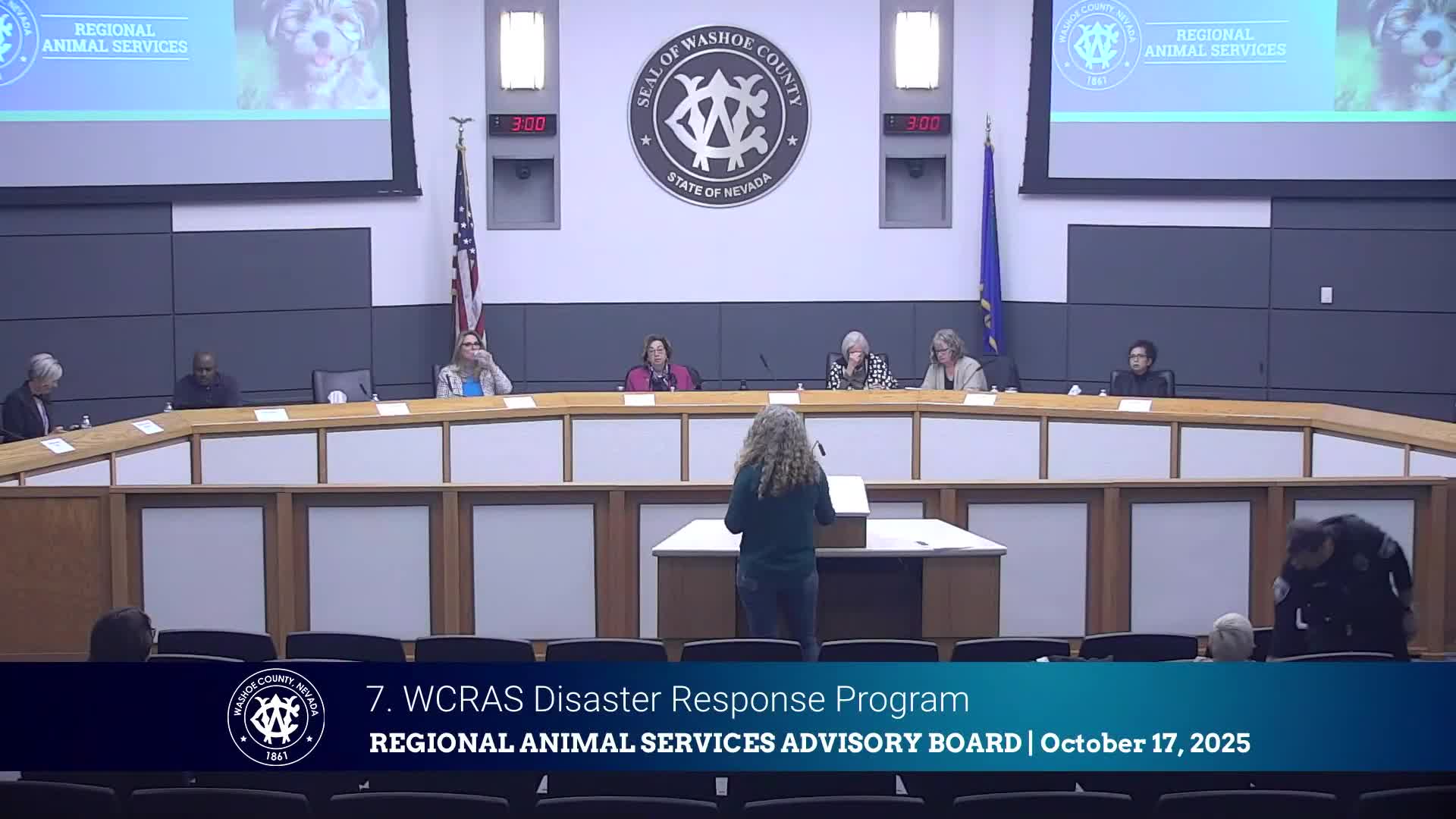Animal services details trailers, evacuation sites and mutual aid; identifies sheltering gaps
October 18, 2025 | Washoe County, Nevada
This article was created by AI summarizing key points discussed. AI makes mistakes, so for full details and context, please refer to the video of the full meeting. Please report any errors so we can fix them. Report an error »

Washoe County Regional Animal Services staff outlined the department’s disaster response tools, mutual‑aid agreements and operational gaps during a presentation to the advisory board.
Field Manager Robert Wooster said animal services participates in monthly emergency management meetings and conducts tabletop and full‑scale exercises for earthquakes, evacuations and wildfires. “We are active members of the Washoe County emergency management team,” he said, describing monthly drills and coordination with county emergency teams.
Tammy Jennings listed response assets: two stock trailers, two small‑animal first‑response evacuation trailers, an expanded small‑animal shelter trailer for longer incidents, a command center used primarily for large‑animal sites and a large‑animal evacuation trailer equipped with feed, panels and supplies. Jennings said operations typically send two people with stock trailers to assess access and safety before a trailer enters a site.
Staff described primary sheltering locations for large animals as the Livestock Events Center and the UNR Equestrian Center; other parks have limited stall capacity. Jennings identified constraints: mobile panels and stalls are harder to stage quickly and staff resources are limited for multi‑week events. The county has voluntary mutual‑aid agreements with Humane World, ASR Assist and Least Resistance Training Concepts (LRTC) to augment staffing and technical large‑animal rescue in major incidents.
Why it matters: wildfire season and other disasters require coordinated animal evacuation and sheltering. Board members raised access concerns during the Davis Fire when roadblocks prevented some residents from retrieving animals; staff said deputies and WebEOC notifications generally funnel requests to animal services but agreed to bring local access issues to the county emergency management table.
Jennings and Wooster closed by urging residents to prepare pet to‑go bags, kennels habituated in advance, alternate evacuation routes and contact information; they said the department will continue to refine SOPs, mutual‑aid plans and staging logistics.
Field Manager Robert Wooster said animal services participates in monthly emergency management meetings and conducts tabletop and full‑scale exercises for earthquakes, evacuations and wildfires. “We are active members of the Washoe County emergency management team,” he said, describing monthly drills and coordination with county emergency teams.
Tammy Jennings listed response assets: two stock trailers, two small‑animal first‑response evacuation trailers, an expanded small‑animal shelter trailer for longer incidents, a command center used primarily for large‑animal sites and a large‑animal evacuation trailer equipped with feed, panels and supplies. Jennings said operations typically send two people with stock trailers to assess access and safety before a trailer enters a site.
Staff described primary sheltering locations for large animals as the Livestock Events Center and the UNR Equestrian Center; other parks have limited stall capacity. Jennings identified constraints: mobile panels and stalls are harder to stage quickly and staff resources are limited for multi‑week events. The county has voluntary mutual‑aid agreements with Humane World, ASR Assist and Least Resistance Training Concepts (LRTC) to augment staffing and technical large‑animal rescue in major incidents.
Why it matters: wildfire season and other disasters require coordinated animal evacuation and sheltering. Board members raised access concerns during the Davis Fire when roadblocks prevented some residents from retrieving animals; staff said deputies and WebEOC notifications generally funnel requests to animal services but agreed to bring local access issues to the county emergency management table.
Jennings and Wooster closed by urging residents to prepare pet to‑go bags, kennels habituated in advance, alternate evacuation routes and contact information; they said the department will continue to refine SOPs, mutual‑aid plans and staging logistics.
View full meeting
This article is based on a recent meeting—watch the full video and explore the complete transcript for deeper insights into the discussion.
View full meeting